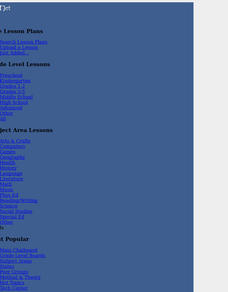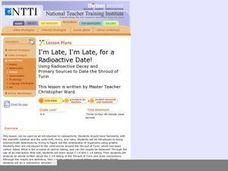Curated OER
Not Just A Bag of Air
Fifth graders label the parts of the respiratory system. They distinguish among the functions of its major organs. They construct a model of the respiratory system. They watch an animated video and utilize the Internet for research of...
Curated OER
What do two-dimensional tessellations look like? Where in art can they be found?
Students explore the world of art and culture, including the works of M.C. Escher. They identify and create original tessellations. Students use a wealth of interactive multimedia applications. They explore the artistic representations...
Curated OER
Making the Right Choice
Students, after discussing and brainstorming a variety of character traits, prepare to incorporate the traits into their own lives. They create, design and present an Interactive PowerPoint presentation with problem solving skills and...
Curated OER
Physical Geography- Climate
Sixth graders explore different climates. In this compare and contrast lesson, 6th graders look at the differences in climates of America and Europe. Students use KWL charts and graphic organizers to record information about different...
Curated OER
Creating the "Perfect" Horse
Students examine the relationship between a horse and its rider. In this behavior and interactions activity students research the Internet to learn about horse behavior and biology then write a paper and present it to the class.
Curated OER
Co-evolution of Plants and Pollinators
Young scholars explore biological evolution and natural selection and its evolutionary consequences. They also explore how organisms are interdependent on one another.
Curated OER
Follow the Road to Riches
Students study the story of gold and silver mining in the San Juan region. Through the use of interactive video and the Internet, they will examine the various events occurring at this time. They create a timeline highlighting the major...
Curated OER
Getting Up the Nerve
Students examine the basics of the nervous system through an interactive program. They discover how the brain is linked to muscle movement. They can test cells through the interactive program to see how it reacts to different stimuli.
Curated OER
On the Road Again
Students examine migration patterns in Africa and China. They watch excerpts from a documentary, define key vocabulary words, complete various student organizers, and create a poster.
Curated OER
SAFETY KNOWLEDGE BASE CHANGES
Middle schoolers research and formulate a hypothesis for research to correlate changing safety regulations in regards to personal and environmental safety polices for storage, handling and disposal of chemicals, risk involved in...
Curated OER
Using Concept Maps to Teach Evolution
Students encounter concept maps for reviewing evolution. Concept maps provides an alternative method of interacting with the information and a forum for asking questions about vocabulary, concepts and interrelationships. A quiz is...
Curated OER
Introduction to Adult Insects and Their Adaptations
Students study organisms found in Class Insecta. They examine the different adaptations these organisms have developed over time to survive and prosper in their respective habitats. They research the origin of the names of several orders...
Curated OER
The First North Americans
Students identify and interpret the different North American Indian groups, by region, and the type and impact of their interaction with Europeans.
Then they complete an overview of one main Native American group during the age of...
Curated OER
Great Basin Tribes- Use of Land for Sustenance
Students explore four Native American tribes from Nevada. In this Native American history instructional activity, students identify and generate important corresponding attributes of the Southern Paiute, Northern Paiute, Washoe, and...
Curated OER
What's the Matter?
Learners explore matter. In this matter and technology instructional activity, students locate examples of solids, liquids, and gases inside and outside the classroom, and record their findings in a graphic organizer. Learners listen...
Curated OER
Very Good Facts About Very Good Books
Students identify the characteristics of fiction and non-fiction texts. For this genre study lesson, students read the books A Butterfly Alphabet Book and I Wish I Were a Butterfly. Students develop a graphic organizer to compare and...
Curated OER
Milkweed and Monarch Butterfly Mania
In this online/interactive worksheet comparing and contrasting Monarch and Great Spangled Fritillary Butterflies worksheet, students read an online comparison and contrast guide, use the graphic organizer, and record the similarities and...
Curated OER
First Contact
Sixth graders have an opportunity to enhance their computer skills by using Internet as a resource tool and a vehicle for global interaction with other students.
Curated OER
I'm Late, I'm Late, for a Radioactive Date!
Through the use of an interactive Web site, students explore C-14 and C-14 dating. Then students analyze an article written about the C-14 dating of the Shroud of Turin and draw conclusions.
Curated OER
What's Matter?
Young scholars explore many of the basic properties of matter including atoms, ions, elements, molecules, and density. The class explores an interactive flash-animated Web site to answer questions and clarify misconceptions they might...
Curated OER
Web of Life - Role-Playing
Students role-play how organisms adapt to their environment. They play 20 questions with plant and animal habitats. They create a web of life to demonstrate how each plant and animal relies on the other for survival.
Curated OER
When in Rome...
Students discuss Roman social classes and create a graphic organizer illustrating each social class and its characteristics. They dress in costumes representative of their social classes as part of a Rome Day experience.
Curated OER
Fueling Around with Energy: A Comparative Study of Conventional and Renewable Energy Use Among Nations
Ninth graders examine the relationship between energy and society. In groups, they define energy sources as renewable or conventional and research how each method contributes to the world's energy. They write about how the patterns of...
Curated OER
Animal Communication
Students use three nonfiction selections in order to investigate the concept of animal communication. They use a graphic organizer for the information as it is gathered in the reading.
Other popular searches
- How Organisms Interact
- How Do Organisms Interact
- Interactions Among Organisms
- Interactions Between Organisms
- Interaction Among Organisms
- Interaction of Organisms

























